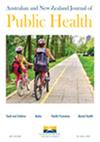澳大利亚成年人的水果、蔬菜和随意食物摄入量:实现2030年人口预防健康目标的过去趋势和预测进展。
IF 2.4
3区 医学
Q2 PUBLIC, ENVIRONMENTAL & OCCUPATIONAL HEALTH
Australian and New Zealand Journal of Public Health
Pub Date : 2025-04-01
DOI:10.1016/j.anzjph.2025.100223
引用次数: 0
摘要
目标:在澳大利亚,“改善获得和消费健康饮食的机会”是国家预防保健战略的一个重点。本文的目的是描述人口摄入量的过去趋势和未来预测,以实现将水果消费量增加到每天2份的战略目标;增加蔬菜至5份;方法:从2015年至2023年收集的275170名澳大利亚成年人的在线调查中获得了自我报告的摄入量数据。根据性别和四个年龄组建立饮食摄入量模型,并使用伽玛广义线性模型预测到2030年。结果:到2030年,水果摄入量预计将减少9.7%,可自由支配食物摄入量预计将增加18.3%,蔬菜摄入量预计将保持稳定(但远低于国家目标)。性别和年龄组的差异包括,18-30岁的人会增加水果摄入量,女性会减少蔬菜摄入量,而男性会增加。结论:如果没有显著的干预,将很难达到澳大利亚的预防健康饮食目标。对公共卫生的影响:持续监测对于提供有针对性的干预措施以改善饮食质量和健康结果非常重要。本文章由计算机程序翻译,如有差异,请以英文原文为准。
Fruit, vegetables and discretionary food intake in Australian adults: Past trends and predicted progress towards population preventive health targets for 2030
Objective
In Australia, ‘improving access to and the consumption of a healthy diet’ is a focus in the National Preventive Health Strategy. The objective of this paper is to describe the past trends and future projections of population intakes against the Strategy’s targets of increasing fruit consumption to 2 servings per day; increasing vegetables to 5 servings; and reducing discretionary foods to <20% of total energy by 2030.
Methods
Self-reported intake data were available from an online survey of 275,170 Australian adults collected between 2015 and 2023. Dietary intake was modelled for sex and four age groups and forecasted towards 2030 using gamma-generalised linear models.
Results
By 2030, fruit intake is predicted to decrease by 9.7%, discretionary food intake predicted to increase by 18.3%, and vegetable intake predicted to remain stable (but well short of national targets). Differences by sex and age group included an increase in fruit predicted for 18-30 year-olds, and a decrease in vegetables for females but an increase for males.
Conclusions
Without significant intervention, it will be difficult to meet Australia’s preventive health dietary targets.
Implications for Public Health
Continuous monitoring will be important to inform targeted interventions to improve diet quality and health outcomes.
求助全文
通过发布文献求助,成功后即可免费获取论文全文。
去求助
来源期刊

Australian and New Zealand Journal of Public Health
医学-公共卫生、环境卫生与职业卫生
CiteScore
4.20
自引率
5.70%
发文量
121
审稿时长
6-12 weeks
期刊介绍:
The Australian and New Zealand Journal of Public Health (ANZJPH) is concerned with public health issues. The research reported includes formal epidemiological inquiries into the correlates and causes of diseases and health-related behaviour, analyses of public policy affecting health and disease, and detailed studies of the cultures and social structures within which health and illness exist. The Journal is multidisciplinary and aims to publish methodologically sound research from any of the academic disciplines that constitute public health.
 求助内容:
求助内容: 应助结果提醒方式:
应助结果提醒方式:


